gem-news-2007-v2

May – August 2007
- August 2007 Newsletter – Aug 15
- Other July & August News – Jul 19 – Aug 10
- July 2007 Newsletter – Jul 17
- June 2007 Newsletter – Jun 15
- May 2007 Newsletter – May 15
August 2007 Newsletter
Pala International News
Gem and Gemology News
Industry News
- Blue Topaz Follow-up: Industry Leaders & NRC Meet, Test Samples
- Pakistan Update
- Quake Effects Linger, Then the Rains
- Pakistan Gems & Jewelry Exports Up
- Present and Future Plans
- Burma News
- Auction News
- More Gold Woes, Weather Woes
- Tycoons “Invade” Jade Mines, Land in Kachin State
Books
- Genuine Diamonds Found in Arkansas
by Glenn W. Worthington - Gemstones: Understanding Identifying Buying
By Keith Wallis
Pala International News
Pala’s Featured Stone: Purple Spinel
This month’s featured stone is an unusually intense purple variety of spinel. With the base hue of a fine amethyst, the slight color shift of a sapphire, and the diagnostic dispersion, this spinel is in a class all its own. For more on color shift see April’s featured stone. Also visit our Spinel Buying Guide.
In many respects, spinel is an ideal gemstone. Its wide range of colour, relatively high refractive index, colour dispersion modestly higher than corundum, good hardness as well as lack of birefringence and cleavage raise it above other, even well known precious stones. Spinel definitely deserves to rank next to ruby and sapphire.
– From Gübelin & Koivula, Photoatlas..., Vol. 2, p. 662.
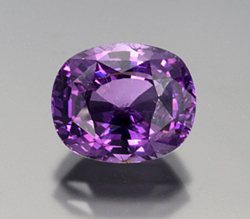 |
| Spinel, 8.13 cts., 10.22 x 9.57 x 6.95 mm. This stone has been sold. (Photo: Wimon Manorotkul) |
To further understand external beauty, we must delve internally to see the features that define the genesis of spinel: randomly oriented growth tubes, rutile needles in an obscure phantom pattern, and platelets flashing spectral colors. This phenomenal mix of inclusions and unique appearance is a refreshing sight. Shall we say “by intelligent design”?
 |
| Internal beauty. Needles and platelets flashing spectral colors following the octahedral-like phantom in a micrograph from this month’s featured gemstone. See more photos here. (Photo: Wimon Manorotkul) |
Browse Pala’s inventory of spinel. Interested? Email us, or give us a call. [back to top]
Bud Standley’s Latest and Greatest Carvings
Bud Standley continues to wow gem enthusiasts with his freeform carvings. Working in a variety of materials, Bud’s ability to bring out aesthetic forms and subtle beauty is well polished. With 36 years of cutting, carving, and polishing under his belt, Bud has refined his craft for all of us to enjoy. Bud’s work is regularly featured in the Bonhams & Butterfields auction catalogs.
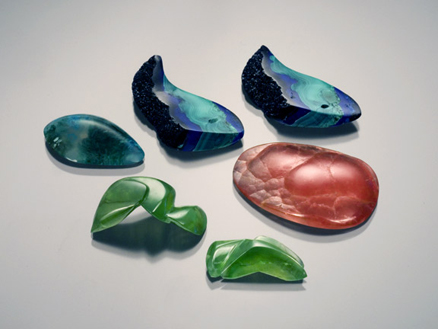 |
| Mixed media. Left to right: chrysocolla-malachite 11.17 cts., azurite-malachite pair 22.92 and 23.74 cts., smithsonite 20.77 cts. and 12.04 cts., rhodochrosite 43.56 cts. Prices available upon request. (Photo: Wimon Manorotkul) |
Not only are Bud’s skills exceptional, but the materials he uses are also noteworthy, as can be seen in the pieces pictured above. The crysocolla-malachite is from Globe, Arizona, and looks like bright green and blue moss growing in a transparent sea. The azurite-malachite pair is from the famous Bisbee Mine in Arizona and exhibits wonderful malachite bands, azurite oolites, and azurite druzy. The green smithsonite is from the 79 Mine near Hayden, Arizona, and glows with a lime green hue. The rhodochrosite is from Kazakhstan and shows a botryodal habit.
Want more information on Bud Standley or gemstone carvings? Email us, or give us a call. [back to top]
Gems and Gemology News
Scottish River Pearls
We received the following information on Scottish river pearls from Alan Hodgkinson, President of the Scottish Branch of The Gemmological Association of Great Britain.
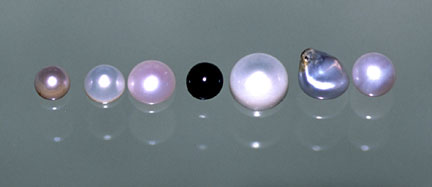 |
| Scottish river pearls from Alan Hodgkinson’s teaching collection. (Photo: Alan Hodgkinson) |
I have attached some Scottish river pearls from my own teaching collection and also a view of the Scottish pearls which I photographed some time ago including the largest Scottish gem pearl—the 44 grain Wee Willie now in the hands of Mrs. Rennie at Cairncross the Jewellers, Perth.
Overfishing and vandalism of the mussel beds in search of the pearls, which was aggravated by smashing the shell fish in search of the rare pearls has almost wiped out the species, never mind the pearl itself. Consequently the Scottish Parliament has introduced legislation aimed at curbing the wanton destruction of the species Margaritifera margaritifera.
Today, the pearls can only be traded by those with a licence. One person who would be most helpful is Alistir Tait, jeweller and gemmologist of Edinburgh. [back to top]
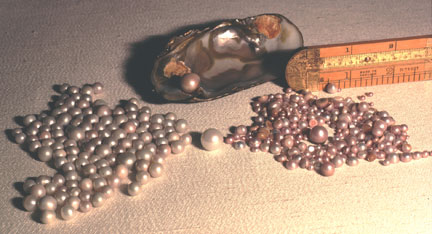 |
| The Wee Willie (center), at 44 grains (14.26 cts.), is the largest Scottish gem pearl. (Photo: Alan Hodgkinson) |
Abalone Pearls: An Update
As a follow-up to last year’s Gem News item on abalone pearls, New Zealander Lou Hill has alerted us to his new website devoted to this natural phenomenon. The website includes an overview of abalone pearl formation and lots of photographs of horn- or tooth-shaped pearls, round pearls, and pearl clusters.
 |
Regarding the pearls in his own collection, Lou Hill told us, “I recently managed to get them expertly examined and X-rayed by Dr. Grahame Brown in Australia and his research was published for further feedback in The Australian Gemmologist and then reproduced in Pearl World: The International Pearling Journal.”
Brown’s article discusses the rarity of the pearls (possibly one in 900,000 animals), length of time required for formation (8–10 years), and distinguishes between formation of pearls found in the shell, peripheral mantle, and gonad. Exactly what causes the formation is still debated, and Brown discusses the various theories. The article, “Unusual Abalone Pearls,” is available from Hill’s home page; look for the “UPDATE” link.
Dr. Brown has made available a 2004 article, “Culturing Abalone Half-Pearls: The story of the New Zealand Eyris Blue Pearl™,” on the Australian Gemmologist website.
A link from Hill’s website includes an article, “Thrill of Finding a Natural Abalone Pearl,” in which he recounts his discovery of natural abalone pearls in the Chatham Islands, 800 km. east of New Zealand. [back to top]
Topaz with Unstable Color
On July 19, a gem dealer in Thailand distributed a trade alert email regarding “orangey to reddish to pinkish brown precious topaz” that “fade[s] to near colorless” upon exposure to direct sunlight for one day.
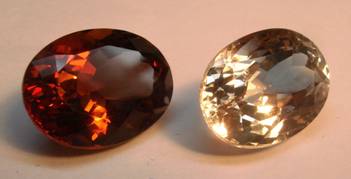 |
| Before... and after. The stone on the right faded after exposure to direct sunlight. (Photo: Jeffery Bergman) |
The dealer, Jeffery Bergman, the American founder of Primagem, said that the gemstones in question have increased in volume significantly over the the past few months.
Some dealers represent these gems as Burmese, others Brazilian. In Chanthaburi they are available for as little as US$1/carat. Unfortunately there are already several Thai based dealers selling them to unsuspecting consumers on eBay with no disclosure of the color stability problem.
I recently acquired three samples from a Chanthaburi dealer, one 18ct, one 22ct and one 36ct. All exhibited a lovely classic strong orangey “sherry” color on the ends of the stone, and a medium slightly orangey brown in the belly.
Bergman said that the origin of the color in these stones remains unknown, but this instability is often seen with material treated with cobalt-60 or X-rays. [back to top]
Industry News
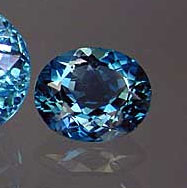 |
| Photo: Wimon Manorotkul |
Blue Topaz Follow-up
Industry Leaders and NRC Meet, Test Samples
Jewelry industry leaders met with representatives of the U.S. Nuclear Regulatory Commission (NRC) on July 26 to discuss irradiated gemstones in general, and imported blue topaz in particular. The meeting, held at NRC offices in Rockville, Maryland, was attended by about twenty reps from American Gem Trade Association, Jewelers Vigilance Committee, and Jewelers of America, International Colored Gemstone Association (ICA)amongst others.
A summary of the meeting was issued by Barbara Lipatapanlop, Executive Director, ICA, and was prepared by Cecilia Gardner, President, Jewelers Vigilance Committee.
NRC Tests Samples. Following the meeting, the NRC conducted tests of nine lots of irradiated topaz, on August 2. The NRC “found all stones tested safe for wearing (eight of the nine samples measured at background radioactivity levels and one twice above), it is not yet ready to declare huge industry backlogs of this gem safe for selling,” according to David Federman’s August 8 story.
The story includes an exclusive statement prepared for Colored Stone by NRC official Scott Moore. It gives the clearest picture of the course being taken by the NRC and how testing fits into it. Just the week before the NRC statement, Federman, who is Colored Stone’s Editor-in-Chief, had done a two-part, in-depth review of the irradiation issue, titled “Topaz Troubles.”
An NRC official declared that “there was nothing alarming from a public health and safety issue,” following the August 2 testing, according to an August 9 article in National Jeweler. More “survey data from the industry” is needed, however, before current inventories are declared safe.
See also these recent items from Gem News on Palagems.com.
[back to top]
Pakistan Update
 |
| Stones like this peridot from Pakistan come from areas that have been hit by rains and landslides. It’s available. |
Quake Effects Linger, Then the Rains
Life for gemstone miners in Pakistan has been challenging, to say the least. The 2005 Kashmir earthquake displaced thousands, and this summer’s monsoons have caused some of those who had been fortunate enough to return, to flee again. While no actual mining areas are mentioned in the following, these are all known to involve mining.
- July 10: Heavy rains ravage Kohistan, Karakorum (Karakoram) Highway, Balochistan
- July 3: Thirteen thousand remain in post-quake camps
As always, we remain grateful for the beauty brought forth from these regions, as miners and their families endure hardships such as these. [back to top]
Pakistan Gems & Jewelry Exports Up
When we last looked at Pakistan’s gem and jewelry exports, there was a clear decline from year 2001–02 through 2005–06—a decline of 40 percent.
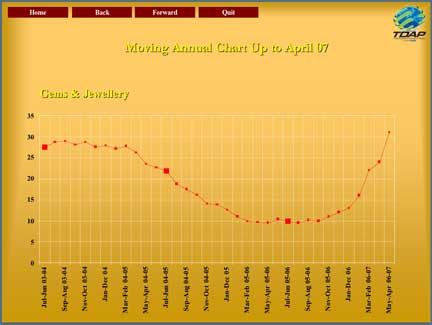 |
| Gems & Jewelry Exports, July 2003 through April 2007. The worst of the slump came between March and September 2006. (Source: TDAP) |
More recent figures show a rise in these exports, especially when jewelry figures are broken out. While gems and jewelry exports Jul-Apr 2006–07 were double those of the year before, jewelry sales were up 55 percent, and gems up 12 percent. [back to top]
Present and Future Plans
The Pakistan government’s Planning Commission issued its Annual Plan 2007–08, which addresses several challenges to overcome in the mineral sector, including:
- Inadequate investment
- Insufficient detailed surveying
- “Lack of vision” in taking advantage of cutting-edge measures
- Inadequate skill levels; little opportunity for training
- Inadequate marketing
Exploitation of Pakistan’s gemstone resources appears to move forward, however slowly.
- Rs 52 million ($860,000) are to be allocated for “Gemstones Training-oriented projects” and “exploration of water in Baluchistan,” according to the Annual Plan. The amount comes out a total earmarked for minerals, of Rs 326 million ($5.38 million)
- The Gemstone Development Centre (also here), which was to offer training on everything from mining engineering to gemology and cutting, still does not appear on the website of its home institution, Peshawar’s University of Engineering & Technology
- The Pakistan Gems & Jewellery Development Company, a non-profit public/private entity, was launched earlier this year. With a laundry list of ambitious objectives, it still has only one page on its website
- In April, a Sri Lankan delegation of gemstone experts met with a Pakistan official, it was reported by Sri Lanka’s Sunday Times and Pakistan’s Daily Times. The Pakistani minister said that his country’s resources could not be tapped at optimal levels due to lack of cutting and polishing facilities, and that Sri Lanka could apply its expertise to such needs
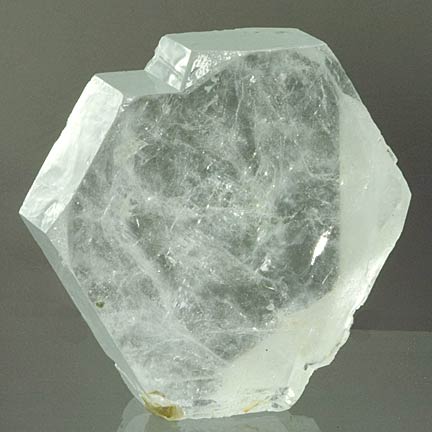 |
| This clear tabular aquamarine is from the Nagar region of Northern Areas, Pakistan. It hails from the Gene Meieran Collection (and has been sold). (Photo: John McLean) |
Finally, we happened upon the following information in a job posting, dated July 30, on Trade Authority of Pakistan (TDAP) website, which may give some insight into the approach being taken.
Currently, Pakistan imports more than 120 tonnes of gold per annum, which makes it the eighth largest consumer of gold in the world. In the year 2002, Pakistan exported gems & jewellery worth US$32 million (which went down to US$28.2 million in 2003). Although, the volume of gems & jewellery exports from Pakistan is of no great significance in the total global trade of US$84.4 billion and much lower than India, who is our biggest regional competitor, nonetheless the growth potential of exports in the sector is huge.
Pakistan has been gifted with abundant resources of several precious and semi-precious gemstones, mostly located in the Northern Areas and the NWFP, but there lies a massive untapped potential in Balochistan.
At present, there is no formal survey available to identify the geological resources of gemstones in the country. Furthermore, due to the lack of realization of its importance as an industry, those who are engaged in the mining, cutting / polishing and trading of gemstones in Pakistan have not been able to exploit the full potential of this sector.
The posting went on to describe the marketing needs.
The Trade Development Authority of Pakistan requires the services of a consultant who could advise on and execute the aggressive marketing of Pakistan’s Gems and Jewellery sector based on Pakistan’s SWOT [strengths, weaknesses, opportunities, and threats] analysis in the face of current and emerging competition.
Their objective would be to establish and strengthen the Marketing of our Gems and Jewellery sector through brand building and marketing and promotional activities in the international arena, integrating it with the world market to make it the driving force of Pakistan’s economic growth, developing an image of quality, trust, reliability, credibility and performance... [back to top]
Burma News
Auction News
• Fourth 2007 Auction to be Held Next Week
The fourth Burma jade and gemstone auction of 2007 is scheduled to be held August 21–25 in Yangon, according to the online weekly The Myanmar Times.
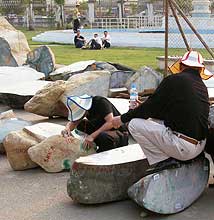 |
| But where can we get one of those hats? From the March 2007 Emporium. (Photo: Mark H. Smith, Thai Lanka Trading Ltd. Part.) |
• July Special Sale was Record Setter
Burma’s Special Sale of Gems, Jade and Pearls, which ended July 16, was its “biggest ever gem auction,” according to Agence France-Presse (AFP) on July 17. According to Pala Gem News statistics, this would put the sale’s figure at above $185 million. The story was echoed a week later in The Myanmar Times (MT).
Gem Lots: Losers. While the MT article claims that jade sales set a record, an unnamed official stated that gem sales amounted to barely 10 percent of lots on offer—“markedly fewer” than those sold at the March 2007 sale. “We could only sell 27 gem lots out of 246,” the official said—20 fewer than at the March sale. He blamed the fall in sales to the cooling Thai economy, even though the same number of Thai merchants attended this sale as in March.
AFP quoted the official Burmese-language newspaper, The Mirror, as saying that total lots sold topped over 70 percent of 6,473 lots offered. The official New Light of Myanmar (print edition) stated on July 18 (with a July 16 dateline) that 4,665 lots of jade, gems, and pearls were sold—nearly 73 percent.
More Gold Woes, Weather Woes
• Gold Mining Banned
In an odd follow-up twist to our report last month, about “Gold Woes” in Kachin, the state’s military commander, Maj-Gen Ohn Myint, has banned gold mining altogether—in areas controlled by both ceasefire groups and the military junta. According to Kachin News Group (KNG) on July 17, the order was given at a meeting conducted by Ohn Myint and ceasefire group delegates, in the Kachin capital of Myitkyina. Ceasefire group sources said that the order had come from Nay Pyi Taw, the national capital.
No reason was given for the ban, but the KNG article states that the main ceasefire group on June 30 “demanded that the ruling junta confer legitimate ethnic rights and rights of self-determination of ethnic state in the new Constitution” and that the junta had been putting economic pressure on the ceasefire groups before the final session of the Nyaung Napyin National Convention, which began July 18.
The reason may be otherwise, however, at least near Indawgyi Lake (south of the Hpakan jade mining area). The Irrawaddy on July 26 quoted a Hopin official: “[The miners] had no legal permission to operate gold mines in the area, and troops from Northern Command arrested them.” Farmers near the lake complained that mining was blocking or diverting streams due to mud.
 |
| Speaking of mud. Travel to Hpakan during the monsoon season is a challenge, to say the least. (Photo: Richard W. Hughes, from this article) |
• Hpakan, Kachin Flooding; Exacerbated by Mining
The Irrawaddy reported last week that rains have washed out roads in the jade and gold mining area around Hpakan (aka Hpakant). The Uru (aka Uyu) River has been compromised, according to a local priest: “A lot of mining companies in Hpakant have thrown sand and stones from the mines into the Uyu River. Now, the river can’t flow smoothly in the rainy season.” [back to top]
Tycoons “Invade” Jade Mines, Land in Kachin State
Kachin News Group reported July 19 that “young Burmese tycoons have literally invaded jade mining areas and arable land in Kachin State in northern Burma,” according to local business sources. The story mentions several companies that have occupied jade mining blocks as well as paddy fields and agricultural fields, some of the occupation aided by Burmese military. Livestock and homes of relocated residents also have been destroyed, according to the article. [back to top]
Books
Genuine Diamonds Found in Arkansas
by Glenn W. Worthington
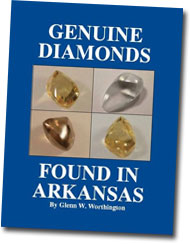 |
This is a new and improved edition on the famous Crater of Diamonds State Park in Arkansas. It now includes 39 new pages with more stories and photographs of this American treasure chest.
Genuine diamonds were first found in Arkansas just over one hundred years ago. Genuine Diamonds Found in Arkansas uses hundreds of photographs, maps, and charts to help tell the story. The author includes first-hand accounts of his diamond finds, and tells about the years he spent in diamond exploration and recovery. This accurate account is a fascinating read.
For more information on the book and ordering information visit the author’s website. [back to top]
Gemstones: Understanding Identifying Buying
By Keith Wallis
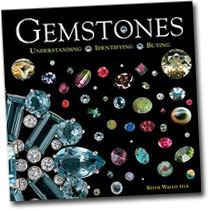 |
While we haven’t yet laid our hands on this book, we thought it of sufficient interest to include here. The author is a Fellow of the Gemmological Association of Great Britain. He was responsible for the design and development of an inexpensive range of test instruments that the student of gemology could afford. The following description comes from the book’s website.
The average person considering buying gem set jewellery or loose stones is faced with a fabulous glittering and colourful array of beauty and value. A wide choice of stones, some with household names, others strange but very attractive. Complicating things even more are the doubts as to which are real and which fake. The situation becomes more difficult each year as techniques for ‘improving’ stones progress and synthetics swamp the market.
Gemstones is a unique book that introduces the layperson to this complex world in simple and easily understandable terms. Describing what constitutes a gemstone, their history, and some myths and legends surrounding them begin the introduction. This is followed by a section covering seventy or so gems with an emphasis on diamond, particularly its identification. A section on organic gems, i.e., ivory, shell, coral, etc. follows. Both these sections are fully illustrated with colour photographs of the stones.
A trip around the world follows, covering many countries visited by those on holiday or business, and describing what, and in some cases where, to buy. Words of warning are also given as to what one should avoid. The influence of the Internet is recognised, with relevant websites helpfully listed. Appendices cover translation in four European languages, physical properties of the gems and colours. A glossary of terms and a comprehensive index is included.
For more information on the book and ordering information visit the Antique Collector’s Club. [back to top]
— End August Newsletter • Published 8/15/07 —
Other July & August News
 |
August 10: NRC Tests Blue Topaz; No Health Threat, No Sign-off
Colored Stone has reported on the results of U.S. Nuclear Regulatory Commission (NRC) testing of nine lots of irradiated blue topaz, conducted on August 2. The NRC “found all stones tested safe for wearing (eight of the nine samples measured at background radioactivity levels and one twice above), it is not yet ready to declare huge industry backlogs of this gem safe for selling,” according to David Federman’s August 8 story.
The story includes an exclusive statement prepared for Colored Stone by NRC official Scott Moore. It gives the clearest picture of the course being taken by the NRC and how testing fits into it.
Just the week before the NRC statement, Federman, who is Colored Stone’s Editor-in-Chief, had done a two-part, in-depth review of the irradiation issue, titled “Topaz Troubles.”
An NRC official declared that “there was nothing alarming from a public health and safety issue,” following the August 2 testing, according to an August 9 article in National Jeweler.More “survey data from the industry” is needed, however, before current inventories are declared safe. [back to top]
 |
August 1: NRC Blue Topaz Meeting Summary
International Colored Gemstone Association (ICA) Executive Director, Barbara Lipatapanlop, today forwarded by email to ICA members a summary of last week’s meeting between industry representatives and the U.S. Nuclear Regulatory Commission (NRC). Read the full story here. [back to top]
 |
July 31: Stuller Suspends Sale of Blue Topaz
Stuller, Inc. has suspended sales of blue topaz stones and jewelry, according to a news release dated July 16.
The Stuller release basically covers the same ground as an earlier Jewelers Vigilance Committee blue topaz update (reported earlier), stating that the jury is still out on how to proceed with irradiated gemstones, blue topaz being one of the most prominent. [back to top]
 |
July 26: AGTA Issues Blue Topaz White Paper
The American Gem Trade Association (AGTA) today issued a “White Paper on Irradiated Blue Topaz.” The document reviews past and current regulations, risk assessment, and outlines AGTA goals regarding the status of blue topaz and other irradiated stones. These goals include:
- Facilitation of radioactivity measurement for current inventories
- Facilitation of future legal importation of irradiated gems
- Lobbying the Nuclear Regulatory Commission (NRC) on behalf of the industry
- Educational and compliance initiatives
AGTA and other industry representatives meet today with the NRC to discuss irradiation issues. [back to top]
 |
July 23: NRC Confronts Blue Topaz Issue
Industry Leaders to Meet with Regulatory Agency
Jewelry industry leaders will meet with the Nuclear Regulatory Commission (NRC) on July 26 to discuss irradiated gemstones in general, and imported blue topaz specifically, it was reported last week by Jewelers Circular Keystone (JCK). The meeting, which will be held in Rockville, MD, will be attended by Rick Krementz of the American Gem Trade Association, Cecilia Gardner of Jewelers Vigilance Committee (JVC), and Tim Haake of Jewelers of America. On the NRC side will be members of the Division of Material Safety and State Agreements, and the Division of Interagency Liaison and Rulemaking.
- Read the full story here [back to top]
July 19: More Burma News...
Special Sale is Record Setter
Burma’s Special Sale of Gems, Jade and Pearls, which ended Monday, July 16, was its “biggest ever gem auction,” according to Agence France-Presse (AFP). The claim was made by on Tuesday by “state media.” According to Pala Gem News statistics, this would put the sale’s figure at above $185 million.
AFP quoted the official Burmese-language newspaper, The Mirror, as saying that lots sold topped over 70 percent of 6,473 lots offered. The official New Light of Myanmar (print edition) stated on July 18 (with a July 16 dateline) that 4,665 lots of jade, gems, and pearls were sold—nearly 73 percent. [back to top]
Tycoons “Invade” Jade Mines, Land in Kachin State
Kachin News Group reports today that “young Burmese tycoons have literally invaded jade mining areas and arable land in Kachin State in northern Burma,” according to local business sources. The story mentions several companies that have occupied jade mining blocks as well as paddy fields and agricultural fields, some of the occupation aided by Burmese military. Livestock and homes of relocated residents also have been destroyed, according to the article. [back to top]
Gold Mining Banned in Kachin
In an odd follow-up twist to our report earlier this week about “Gold Woes” in Kachin, the state’s military commander, Maj-Gen Ohn Myint, has banned gold mining altogether—in areas controlled by both ceasefire groups and the military junta. According to Kachin News Group (KNG) on July 17, the order was given at a meeting conducted by Ohn Myint and ceasefire group delegates, in the Kachin capital of Myitkyina. Ceasefire group sources said that the order had come from Nay Pyi Taw, the national capital.
No reason was given for the ban, but the KNG article stated that the main ceasefire group on June 30 “demanded that the ruling junta confer legitimate ethnic rights and rights of self-determination of ethnic state in the new Constitution” and that the junta had been putting economic pressure on the ceasefire groups before the July 18 final session of the Nyaung Napyin National Convention. [back to top]
July 2007 Newsletter
Shows and Conferences
Pala International News
Industry News
- Burma News
- Snapshot of Jade Mining in Phakant, Kachin State
- Tax Collection by Force at Kachin Gates
- Special Gem Sale Underway
- Gold Woes
Novelties
- Gemstone Trading Cards
German collectibles from the turn of the 19th century
Shows and Conferences
Pala at JA New York Summer Show
July 29–August 1, 2007
Pala International heads to the East Coast later this month for the trade-only JA New York Summer Show. Stop by to see one of America’s largest selections of fine colored gems.
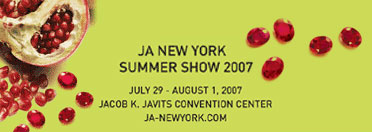 |
When: July 29–August 1, 2006
Where: Jacob K. Javits Convention Center
Hours: AGTA Gemstone Section
Sunday, July 29: 9:30 AM – 6:00 PM
Monday, July 30: 10:00 AM – 6:00 PM
Tuesday, July 31: 10:00 AM – 6:00 PM
Wednesday, August 1: 10:00 AM – 3:00 PM
Pala International is in booth 1361. See the JANY website for more information. [back to top]
Pala International News
Pala’s Featured Stone: Fire Opal
Mexican fire opal comes to us with a variety of characteristics. Yellow to deep orange body color with the very unusual hues moving into the reds. Like opal from other parts of the world, Mexican fire opal can display full-spectrum play of color. This month’s phenomenal featured stone has all the components of a top notch collector’s gem.
 |
| Mexican fire opal, 23.15 cts., 22.99 x 16.93 x 11.82 mm. This stone has been sold. (Photo: Wimon Manorotkul) |
As we look internally, we find another visually stimulating characteristic: stalagmite and stalactite formations occur within fire opal and are usually composed of goethite rods encrusted in limonite (Gübelin & Koivula: Photoatlas). There also seems to be some hematite crystals inside. See the inclusion photo below for the internal world of this month’s featured stone. (More photos available here.)
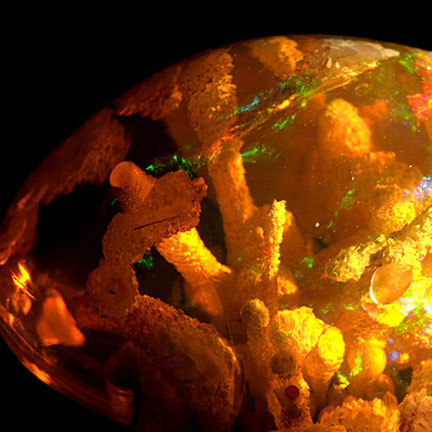 |
| Fire and water. Coral-like stalagmite/stalactite formations are clearly seen in this magnification of this month’s featured fire opal. See more micrographs here. (Photo: Wimon Manorotkul) |
Interested? We have a couple of other exceptional pieces. Email us or give us a call. [back to top]
Industry News
Burma News
Snapshot of Jade Mining in Phakant, Kachin State
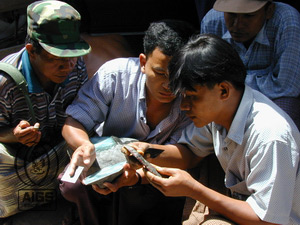 |
| Traders study a slice of jadeite in the Mandalay jade market. (Photo: Vincent Pardieu.) |
Details are emerging regarding Burma business tycoon Te Za’s jade mine operations in Phakant, Kachin State, in northern Burma. (We reported on the commencement of operations in May.) Te Za’s Htoo Trading Company is involved in an alliance with the Myanmar Dagaung Co. Ltd. Both companies are close to the leaders of Burma’s military junta. The companies are operating and will continue to operate all jade mines in Phakant.
According to a July 5 Kachin News Group article, the mining operations employ “[o]ver 15 hydraulic earth diggers and over 20 Volvo 12-wheel trucks... in Kawng San and Tawng Kaw mines.” The trucks are unlicensed, by special permission of the junta. For an overview of the career of Te Za and other “business czars” of Burma, see “Tycoon Turf” (The Irrawaddy, September 2005). [back to top]
Tax Collection by Force at Kachin Gates
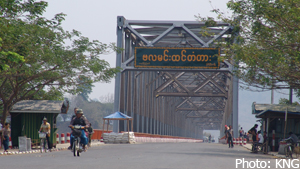 |
| Kachin gate. Taxes collected at three major gates are shared by as many as 18 government agencies. (Photo: Kachin News Group) |
On July 3, the Kachin News Group reported that “almost all multi-governmental agencies of the Burmese military junta are forcibly collecting tax from local traders at the three major gates in Kachin State.” Items being taxed illegally include jade, food, teak, and timber. [back to top]
Special Gem Sale Underway
A Special Sale of Gems, Jade and Pearls currently is underway in Yangon. According to the official New Light of Myanmar (NLM) print edition on July 13, “4,032 jade lots have been sold through tender and competitive bidding systems” during the sale. A July 5 NLM article stated that 349 lots of pearls, 246 lots of gems, and 5,878 lots of jade would be sold. The sale ends July 16.
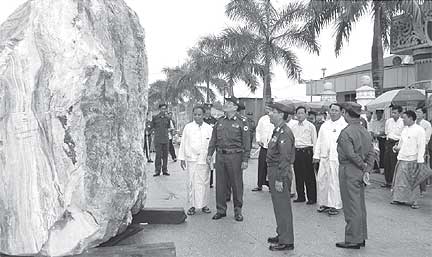 |
| Special sale. Lt-Gen Myint Swe tours the site of the special sale. (Photo: New Light of Myanmar, print edition) |
Gold Woes
The Myanmar Times reported earlier this month on the struggle of goldsmiths due to the high price of gold. “On the domestic market prices in 2005 jumped from K632,500 an ounce to more than K1.4 million an ounce in less than a month.” The article quotes a goldsmith as saying that “the majority of people cannot afford to buy gold at such high prices.” Mine shutdowns due to weather and landslides also have affected the situation.
The Kachin Development Networking Group (KDNG), a coalition of NGOs, has published a study on gold mining and militarism in Burma’s Hugawng Valley, entitled “Valley of Darkness” (3.8MB; requires free Adobe Reader). The study discusses the impact of gold mining on local people and their environment, since the cease-fire with rebels in 1994. Gold mining also is threatening a large tiger reserve in the area, according to the KDNG. [back to top]
Novelties
Gemstone Trading Cards from the Turn of the Century
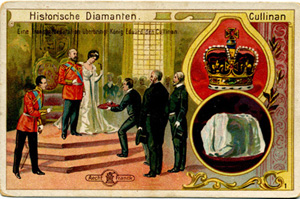 |
| Photo: Pala International |
Burma Bill is now the “French Connection.” He was in France recently at the Sainte-Marie-aux-Mines show. This is mainly a mineral show, but there were plenty of other gem-type collectibles to be found. Bill, being a connoisseur of the truly rare and unusual, bought 33 colorful and beautifully illustrated cards. One set features famous gemstones (see, for example, the Cullinan Diamond at right). A second set depicts scenes involving different levels of the gem trade—from mining to adorning. Bill also obtained a set featuring all the major gem varieties coupled with a corresponding character (shown below). The set was issued by the chocolatier Hartwig & Vogel.
These baseball card-like items are called chromolithographs. They were made around the turn of the (19th) century and all are in the German language.
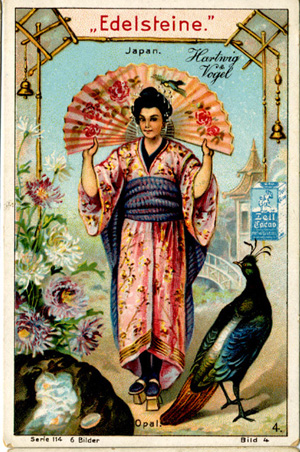 |
| 4. Opal (above) features a Japanese theme. 5. Emerald (below) depicts and aristocratic falconer from the Caucasus region of Eurasia. (Photos: Pala International) |
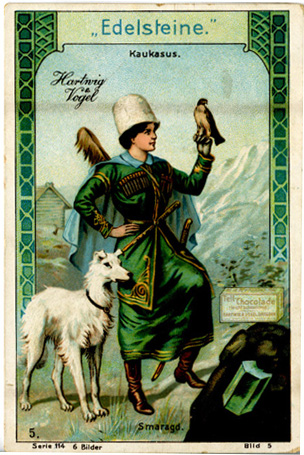 |
[back to top]
— End July Newsletter • Published 7/15/07 —
June 2007 Newsletter
Shows and Conferences
Pala International News
Gem and Gemology News
Industry News
- AGTA CEO Douglas Hucker Resigns
- Burma News
- Burma Nears $300 Million in 2006–07 Gem Sales
- Russia Aids Burma in Search for Uranium in Jade Mining Area
- China Engineers Burma’s Hydroelectric Generation in Kachin
Books
- Frozen Light: The Eternal Beauty of Crystals
by Lawrence Stoller - Pink Pearl: A Natural Treasure of the Caribbean
After the text by David Federman, adapted by Hubert Bari
Shows and Conferences
Leaving Las Vegas
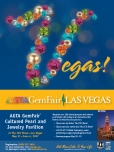 |
The paraiba saga continues as the hot topic in the gem trade, as evidenced in Las Vegas this month. There’s still a lot of discussion and intrigue surrounding these copper-bearing tourmalines: Where are they from? Are they natural? Why are we all drawn to their neon colors? It seemed like no one could walk by our booth without pausing to hover over our showcase full of Mozambique tourmaline. The beautiful array of new colors from this deposit is still quite captivating. Purples, lavenders, mint greens, and of course the “paraiba” blues that first seized the interest of the gem industry.
There were a lot of dealers displaying the Mozambique material, but upon closer investigation a majority of it was heavily included and lighter in saturation. A few dealers are insistent on reserving the term “paraiba” for the gems originating from Brazil. Most, however, have adopted the term as a color and they simply disclose the country of origin in the description. No matter what we call them, all of us seem to be under the spell of these glowing beauties. There was even a Paraiba Party this year in the penthouse of the Venetian. The V.I.P. invitation below shows the purplish violet rough behind an inspiring electric blue oval brilliant.
See the exciting neon color in Pala’s inventory here.
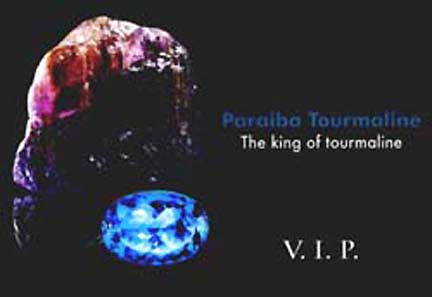 |
| Penthouse party. Invitation to V.I.P. event held in Las Vegas’s Venetian Hotel. |
[back to top]
Pala International News
Pala’s Featured Stone: Star Ruby
Star, or asterism, is a phenomenon that appears when light is reflected from oriented inclusions in corundum. These silk inclusions are exsolved needles of rutile, oriented along three directions in a basal plane. Light is reflected and concentrated into bands perpendicular to the three directions; if everything is in alignment inside and outside the stone, a 6-ray star will magically appear. (Adapted from Richard W. Hughes, Ruby & Sapphire, p. 67.)
 |
| Star ruby, 7.53 cts., 10.22 x 9.57 x 6.95 mm. Search on inventory number 13873. (Photo: Wimon Manorotkul) |
This star ruby comes to us from Mogok, Burma. With a pinkish-red hue and good translucency this beauty is a pleasing sight. Beyond the color, the star is very sharp and all the rays are well defined.
Please give us a call regarding this as well as other star rubies we have in stock.
Interested? Select the inventory link above for pricing, email us, or give us a call. [back to top]
Gem and Gemology News
Christie’s Sets Blue Diamond Record
A sale in London this week set a per-carat record for a blue diamond, at $655,480. The circular-cut grayish-blue diamond, 7.81 carats, was offered as part of Christie’s June 13 sale [click for photos] that featured two royal collections from Italy and Yugoslavia.
The blue diamond, in a ring of a ca. 1920 vintage, is claimed by Christie’s to be “one of the finest examples of its type,” according to a press release.
Also setting a record at the same sale was an antique diamond tiara, ca. 1890 by Fabergé, and hails from the collection of Princess Maria Gabriella di Savoia, the daughter of the last king and queen of Italy, Umberto II and Maria José. The tiara sold for $2,071,388. [back to top]
Industry News
AGTA CEO Douglas K. Hucker Resigns
 |
The American Gem Trade Association (AGTA) announced Thursday the resignation of Douglas K. Hucker, as Chief Executive Officer. Hucker had served as CEO for the past ten years, after serving on the trade organization’s Board of Directors.
No reason was given for the resignation in this AGTA press release. According to the release, Hucker will continue to serve the AGTA for the next six months in an advisory capacity.
AGTA Chief Operating Officer Ed Griffin will act as the primary contact until a new CEO is appointed. [back to top]
Burma News
Burma Nears $300 Million in 2006–07 Gem Sales
Burma gemstone exports reached $296.9 million for the fiscal year ending in March 2007, Customs Department figures reveal. The online weekly, The Myanmar Times, which carried the story on June 4, reported that an unidentified Myanma Gems Enterprise (MGE) official said that the three jade and gem emporiums held over the last twelve months made up the bulk of the income. “Jade production increased and Chinese passion for jade pushed up prices and demand,” he said.
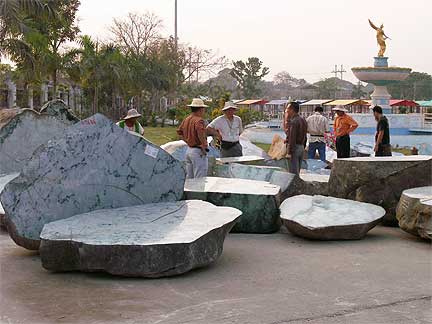 |
| Bolder boulders. Jadeite boulders are displayed in the open air at the March 2007 Myanma Gems Emporium. (Photo: Mark H. Smith, Thai Lanka Trading Ltd. Part.) |
Out of $5.01 billion from various economic sectors, MGE came in third, behind oil and natural gas ($2.16 billion) and timber ($519 million). Total dollars obtained in foreign trade were 7.93 billion, a 43 percent increase over the previous year, with a $2.09 billion surplus.
In an earlier story, it was claimed that a decline in black market trade was partly responsible for the large surplus. U Myo Oo, deputy director general of the Directorate of Trade, asserted that upwards of 70 percent of illegal border region trade had moved into legitimate channels. The Ministry of Commerce put the percentage of normal trade versus border trade at 80 percent versus 20 percent, respectively. [back to top]
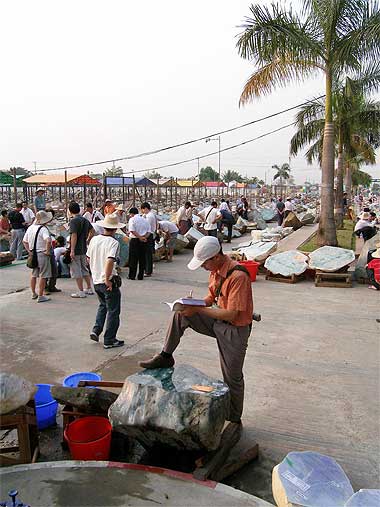 |
| No ordinary footstool. This year’s Myanma Gems Emporium topped $125 million. See all the Burma sales statistics here. (Photo: Mark H. Smith, Thai Lanka Trading Ltd. Part.) |
Russia Aids Burma in Search for Uranium in Jade Mining Area
Burmese and Russian experts are exploring for uranium in Burma’s famous Hpakant Township jade mining area, in the northern Kachin State. A June 12 Irrawaddy story quotes a “high ranking military intelligence official with the Kachin Independence Organization” as saying that eight foreigners have been drilling for three months in the Hawng Pa village area. The exploration in Kachin is new—the government having previously acknowledged deposits in five other areas of Burma. (Residents from two other areas also have called attention to local exploration efforts.)
Uranium could be employed in a 10-megawatt nuclear reactor—a joint venture between Russia’s atomic energy agency and the Burmese junta. The reactor would power a “nuclear research center” in Burma, announced last month, causing some observers to suspect ulterior motives, with some foundation, as reported in World Politics Review on June 8. The junta is signatory to the 1995 Bangkok Treaty, which bans development of nuclear weapons. [back to top]
China Engineers Burma’s Hydroelectric Generation in Kachin
Power in Kachin State will be generated by another source, if current plans are undertaken by the China Power Investment Corporation to build seven new hydroelectric plants, totaling 13 megawatts—ten times the current generation capacity, as reported by Xinhua. Burma’s ruling junta has been criticized for environmental concerns surrounding its hydro projects, and the fact that much of the energy produced will not be consumed in Burma, but by Thailand and, in the case of Kachin production, China’s Yunnan province. [back to top]
Books
Frozen Light: The Eternal Beauty of Crystals
by Lawrence Stoller
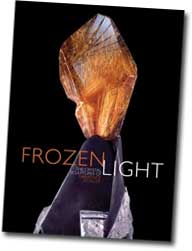 |
In a new monograph of his work, artist Lawrence Stoller gives us a little history of his immersion into the world of crystals and reveals “the fact that the book was writing me.” The book is mainly filled with gorgeous photographs of his creations, while the text is devoted to his poetic explanations and recollections of far-out journeys.
Lawrence takes us on a trip through the creative process—from selecting crystals, to sculpting and polishing, incorporating mixed media, creating a stable platform, and obtaining the final aesthetic beauty of a complete work of art. These surreal formations of “frozen light” blend the artistry of man and the intricacies of nature.
From the book: “There is no earthly substance that combines technology, artistry, healing, mineralogy, physics, philosophy, and metaphysics with the deep, wise, transparent beauty that grand crystals possess.”
For more information, visit the CrystalWorks website.
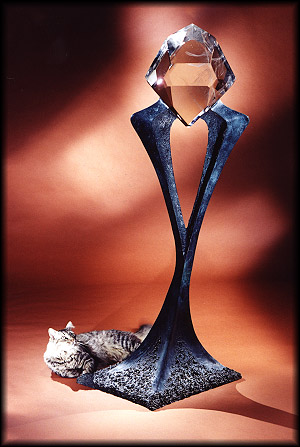 |
| “Ancestor” (above), featuring Russian quartz, and a detail of “Dreamer,” featuring Brazilian citrine. (Photos courtesy Lawrence Stoller CrystalWorks) |
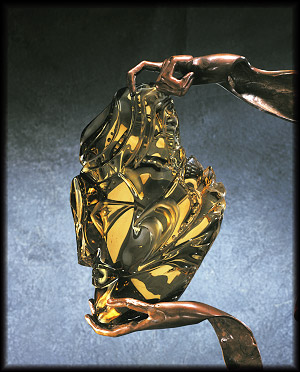 |
[back to top]
Pink Pearl: A Natural Treasure of the Caribbean
After the text by David Federman
Adapted by Hubert Bari
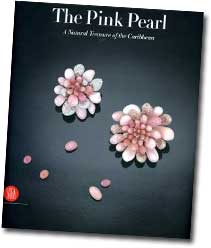 |
This colorful and informative book takes us on a voyage in search of the rare and elusive pink pearl and its migration into the world of fashion. Set in the brilliant blue waters of the Caribbean we get a glimpse into the lives and lifestyles surrounding the queen conch shells that produce these pink beauties. We’re taken from the local conch shell and meat used by the natives, to collectors like Sue Hendrickson, who seeks out and dives for the pearls.
Beyond the hunting grounds we follow a collection of 30,000 pearls as they disseminate into jewelry design and fashion. The popularity of the pink pearl is in a renaissance period, with an expanding market for natural pearls and rare collectables. Visually stunning—and a fabulous story.
For more information on the book, which is set for release this fall, visit the publisher’s website. [back to top]
— End June Newsletter • Published 6/15/07 —
May 2007 Newsletter
Shows and Conferences
Pala International News
- Pala’s Featured Stone
- The Collector Fine Jewelry Open House
- Attention Gemstone Cutters and Carvers!
- This Just In! – Multicolored Paraiba Tourmalines from Mozambique
Gem and Gemology News
Industry News
Shows and Conferences
Pala at Las Vegas – May 31–June 4, 2007
 |
It’s time for the JCK Las Vegas show. Pala International will be there in force, with one of America’s largest selections of fine colored gems. The AGTA Pavilion opens one day early—Thursday, May 31—before the main JCK Show.
When: May 31–June 4, 2007
Where: Venetian Hotel Grand Ballroom adjacent to the Sands Expo & Convention Center, Las Vegas, NV
Hours: AGTA Gemstone Section
Thursday, May 31: 10:00 AM - 6:00 PM
Friday, June 2 to Monday, June 4: 9:00 AM - 6:00 PM
Booth: AGTA Pavilion, booth 34308
We look forward to seeing our many friends there. Visit the Pala International Show Schedule for future events. [back to top]
Sainte-Marie-aux-Mines – June 21–24, 2007
Pala International’s Bill Larson attends this event every year, held in the midst of the Alsace wine region of northeastern France. See his report from the 2006 show.
What: Euro-Mineral/Euro-Gem
When: June 21–24, 2007
Where: Sainte-Marie-aux-Mines, France
Bill looks forward to seeing you there. [back to top]
Pala International News
Pala’s Featured Stone: Russian Demantoid Garnet
Demantoid garnet truly captures the spirit of gemstone collecting. A rare and beautiful gem with provenance and gemological intrigue.
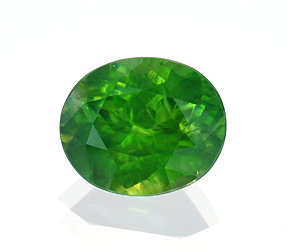 |
| Russian demantoid garnet, 3.69 ct, 10.02 x 8.36 x 5.77 mm. Inventory #14687. A fine example of high saturated green and medium tone. (Photo: Wimon Manorotkul) |
Originally discovered in the Ural Mountains of Russia in 1853, these Ural pearls captured the imagination of the likes of reigning Czars, Peter Carl Fabergé, and George F. Kunz of Tiffany’s. The initial mining operations and popularity lasted until about 1919 when demantoid went off the radar. It wasn’t until the 1970s when demantoid resurfaced in limited production along some of the rivers leading out of the Urals. Small scale operations have been sporadic over the last few decades, which included a serendipitous effort by Bill Larson and Pala International to recover some of these green beauties in the late 1990s. Our featured stone this month comes from some of the last premium lots that were coaxed out of the ground.
 |
| Horsetail inclusion, the identifying mark of excellence—from Russia with love... (Photo: Wimon Manorotkul) |
Demantoid is a highly saturated green variety of andradite garnet. The exquisite dispersive properties of this garnet are similar to a diamond, with flashes of color from our visible spectrum. Lighter tones tend to pronounce the dispersion while darker tones show less fire. To further identify these green Russian beauties, most contain horsetail inclusions. These golden byssolite threads occur in curved sprays, resembling horse tails, and are diagnostic of Russian origin.
Demantoid garnets have now been found in Iran, Italy, and Namibia; however the original Russian material seems to hold its place as the finest. With some of the last material available on the market Pala offers a fine selection of demantoid. See the inventory here.
For more information, see:
- Pala’s Gem Spectrum – an issue devoted to demantoid garnet; includes our Demantoid Garnet Buying Guide, by Richard W. Hughes
- Wikipedia on Demantoid
Interested? Select the inventory links above for pricing, email us, or give us a call. [back to top]
Open House at The Collector Fine Jewelry
Featuring “Paraiba” Tourmaline from Mozambique
 |
Pala International’s sister enterprise, The Collector Fine Jewelry, presents a special open house event, this coming Friday, May 18, and Saturday, May 19.
You’ve been reading about paraiba tourmaline for months here in Gem News. Now see a selection of what Mozambique has to offer in the way of paraiba-type tourmaline.
Where: Collector Fine Jewelry
912 South Live Oak Park Rd.
Fallbrook, CA 92028
When: May 18 & 19, 2007
For more information, click on the invitation above (requires free Adobe Reader), or call The Collector at 760.728.9121 or 800.854.1598. [back to top]
Attention Gemstone Cutters and Carvers!
Rutilated, Smoky, and Tourmalinated Quartz Available
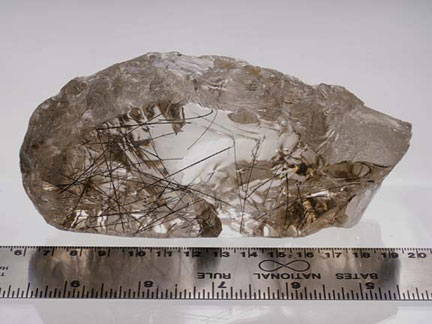 |
| Tourmalinated quartz. Thin black tourmaline needles running through this piece of rough from the Grieger collection. (Photo: Wimon Manorotkul) |
Large chunks of rutilated, smoky, and tourmalinated quartz are available from the Grieger collection recently acquired by Pala. Call to inquire! [back to top]
This Just In!
Multicolored Paraiba Tourmalines from Mozambique
Pala’s Bill Larson is back from Asia, where he picked up this trio of luscious paraiba-type tourmalines from Mozambique. Tourmalines from this area in Mozambique continue to surprise us with surreal colors. This is another striking reminder of how pure and vibrant color can be when Mother Nature adds copper to the mixture.
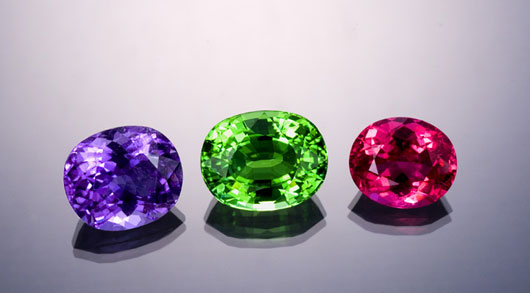 |
| Paraiba tourmalines from Mozambique. Violet/purple, 13.09 cts.; minty green, 16.31 cts.; cherry red 9.25 cts. (Photo: Wimon Manorotkul) |
The shipment from which these were taken just arrived yesterday and we simply couldn’t wait to let you know about them. They’re sure to go fast... Give us a call.
See more exciting neon color in Pala’s inventory here. [back to top]
Gem and Gemology News
Christie’s Sets Records for Sapphire, Pearls
22-carat Kashmir Sapphire and Baroda Pearl Necklace
Fetch Combined $10 Million
Just before Pala’s Bill Larson returned from Asia, he emailed us: “Get the news on the Kashmir sapphire sale. 3 million ! record. A real buzz here in Asia.”
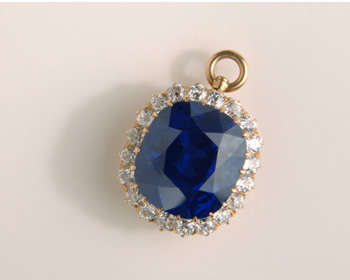 |
| Proceeds from the $3 million sale will benefit an endowment for the historic James J. Hill House in St. Paul, Minnesota. (Photo courtesy Minnesota Historical Society) |
On April 25, Christie’s New York announced world record prices for a sapphire and natural pearls. Rahul Kadakia, Head of Jewelry for Christie’s Americas, said,
In a packed room, an Asian private collector on the phone made history acquiring the legendary Baroda Pearl necklace for more than $7 million, while an anonymous bidder paid more than $3 million for an exceptional 22 carat Kashmir sapphire, making it the most expensive sapphire in the world. This auction marks a turning point in the jewelry world where original design, rarity and provenance prove to be just as important as the quality of a gem.
The sapphire also set a record for price per carat, at $135,000. It once was part of a sapphire and diamond necklace given Mary Hill in 1886 by her husband, James J. Hill, known as the “Empire Builder” due to, among other business ventures, his successful development of a 1,700 mile transcontinental railroad without public money or land grants—and without going bankrupt.
The pearl necklace—touted as “the most important pearl necklace ever seen at auction”—was offered en suite with ear pendants, a brooch, and ring. Pearls in the two-strand necklace once belonged to an historic seven-strand necklace. [back to top]
SSEF Testing and Reporting of Paraiba Tourmaline
Following our February 2007 update on gemological lab policies regarding paraiba-type tourmaline, we received a note from another laboratory—SSEF Swiss Gemological Institute.
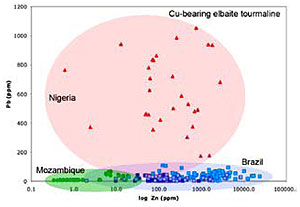 |
| Diagram of LA-ICPMS data (Pb versus log Zn, ppm). Red: Nigeria, blue: Brazil, green: Mozambique. (Diagram © M.S. Krzemnicki, SSEF 2006; used by permission) |
Dr. Michael S. Krzemnicki, Deputy Director SSEF and Director of Education for the institute, forwarded information describing how the SSEF lab is able to determine origin of copper-bearing tourmaline. Using ED-XRF, LIBS, and LA-ICPMS analysis, “careful data plotting reveals distinct differences which allow us to separate the origin of these tourmalines in most cases.”
Dr. Krzemnicki also sent us the language used in SSEF gemstone reports for paraiba-type tourmaline:
Identification: Elbaite Tourmaline
Comment: This copper bearing elbaite tourmaline may also be called paraiba tourmaline in the trade.
Origin: Mozambique
See the full annual report here (1.1 MB; requires free Adobe Reader). [back to top]
Industry News
Son of Franken-stone: An Update on Irradiated Gemstones
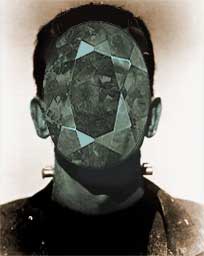 |
We’ve received a couple of responses to our December story, “Red Hot and Blue: Irradiated Blue Topaz,” in which we discussed safety issues surrounding irradiated blue topaz. One reader, a trade member from Thailand, asked about other irradiated stones, such as kunzite and smoky quartz. Another reader, a prominent scientist, questioned why we were resurrecting the issue of “Franken-stones” when it had been settled in the 1980s by government action both here and abroad.
So we sought out clarification of the science and treatment methodology from John L. Emmett, an expert in the physics, chemistry, and heat treatment of corundum. He also weighed in on whether government regulation of irradiated material has been entirely successful.
And we thought it might be time to contact our industry insider to find out whether there had been movement regarding self-regulation on safety issues. Finally, we noticed a Modern Jewler article last month by David Federman, regarding a new topaz enhancement that’s an alternative to irradiation.
Read “Son of Franken-stone: An Update on Irradiated Gemstones.” [back to top]
Trust: The Ethics of Gem Treatment Disclosure
An article by John L. Emmett
 |
Dr. Emmett discusses the merits of fostering understanding and education on the part of the buyer. He says they “are crucial to everyone’s success.”
“The concept is simple: fair play. It seeks to ensure that no single member of the supply chain can prey upon another.” Read the article, reproduced from Jewellery News Asia, on Richard W. Hughes’s Ruby-Sapphire.com. [back to top]
Also on Ruby-Sapphire.com
“Brilliance, Windows and Extinction in Gemstones” and
“Crystal Optics”
Hughes is mining his back room for practical guides for the gemologist. He’s recently posted two pieces that should prove useful. “Brilliance, Windows and Extinction in Gemstones” examines these phenomena as they relate to the grading of colored gemstones. From the abstract: “Diagrams are provided which show for the first time that extinction is largely a function of cut. It is the author’s opinion that in any attempt at cut grading of colored stones, each of these three phenomena must be taken into account.” “Crystal Optics” is an overview of crystal systems and their optical properties, presented in tabular form. [back to top]
Recent Burma News
The following news items pertaining to Burma were published since our last Gem News.
- Burma to Grant More Jade Mining Blocks to Local Businesses: Burma will grant 319 mining blocks to local entrepreneurs, People’s Daily Online reported May 4. Each block measures one acre and will be leased for three years.
- Te Za Begins Mining in Phakant: Burma tycoon Te Za has begun jade mining operations in Phakant, in the Kachin State of northern Burma, Burma News International reported May 1. The area was confiscated with the help of the Phakant-based military junta, displacing “over 30 households in each mine area.” The households received compensation.
- Burma Forms First Gem Merchants Association: Burma's largest business organization and the Ministry of Mines are facilitating formation of the country’s first rough-gem merchants association, the Myanmar Gem Merchants’ Association, Rapaport reported April 15.
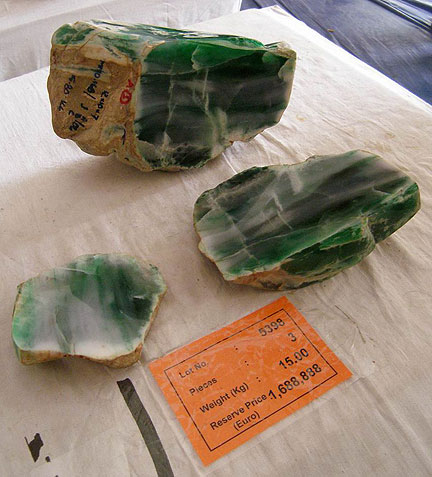 |
| Burmese jadeite...at a price. Illumination by flashlight reveals exquisite translucency in this jadeite material at the March 2007 Myanma Gems Emporium. (Photos: Mark H. Smith, Thai Lanka Trading Ltd. Part.) |
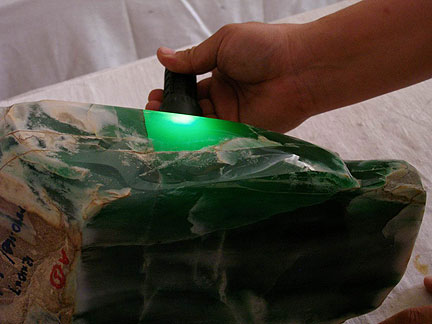 |
Burma Political Developments of Interest
- Burma Junta Prepares for Free Trade Talks, from The Irawaddy, May 11
- ASEAN, EU Agree to Launch Free Trade Talks After Wrangling Over Burma, from Associated Press (AP), May 4
- Bush to Hold First Summit with ASEAN Leaders in Singapore, from Agence France-Presse, May 4
- ASEAN Aims to Ink Free Trade Pact with Japan, from AP, May 3
- Burma–Thai Bilateral Trade Up Over 50% in 2006–07, from Xinhua, April 30 [back to top]
— End May Newsletter • Published 5/15/07 —
Note: Palagems.com selects much of its material in the interest of fostering a stimulating discourse on the topics of gems, gemology, and the gemstone industry. Therefore the opinions expressed here are not necessarily those held by the proprietors of Palagems.com. We welcome your feedback.